German Democratic Republic (GDR): history, capital, flag, coat of arms. Unification of the GDR and the FRG, historical facts
The German Democratic Republic, or GDR for short, is a country located in the Center of Europe and marked on maps for exactly 41 years. This is the westernmost country of the socialist camp that existed at that time, formed in 1949 and became part of the Federal Republic of Germany in 1990.
German Democratic Republic
In the north, the border of the GDR ran along the Baltic Sea, on land it bordered on the FRG, Czechoslovakia and Poland. Its area was 108 thousand square kilometers. The population was 17 million people. The capital of the country was East Berlin. The entire territory of the GDR was divided into 15 districts. In the center of the country was the territory of West Berlin.
Location of the GDR
On a small territory of the GDR there was a sea, mountains and plains. The north was washed by the Baltic Sea, which forms several bays and shallow lagoons. They are connected to the sea by straits. She owned the islands, the largest of them - Rügen, Usedom and Pel. There are many rivers in the country. The largest are the Oder, Elbe, their tributaries Havel, Spree, Saale, as well as the Main - a tributary of the Rhine. Of the many lakes, the largest are Müritz, Schweriner See, Plauer See.
In the south, the country was framed by low mountains, significantly cut by rivers: from the west, the Harz, from the south-west, the Thuringian Forest, from the south, the Ore Mountains with the highest peak Fichtelberg (1212 meters). The north of the territory of the GDR was located on the Central European Plain, to the south lay the plain of the Macklenburg Lake District. South of Berlin stretches a strip of sandy plains.

East Berlin
It has been restored almost completely. The city was divided into occupation zones. After the creation of the FRG, its eastern part became part of the GDR, and the western part was an enclave, surrounded on all sides by the territory of East Germany. According to the constitution of Berlin (Western), the land on which it was located belonged to the Federal Republic of Germany. The capital of the GDR was a major center of science and culture of the country.
The Academies of Sciences and Arts, many higher educational institutions were located here. Concert halls and theaters hosted outstanding musicians and artists from all over the world. Many parks and alleys served as decoration for the capital of the GDR. Sports facilities were erected in the city: stadiums, swimming pools, courts, competition grounds. The most famous park for the inhabitants of the USSR was Treptow Park, in which a monument to the liberator soldier was erected.
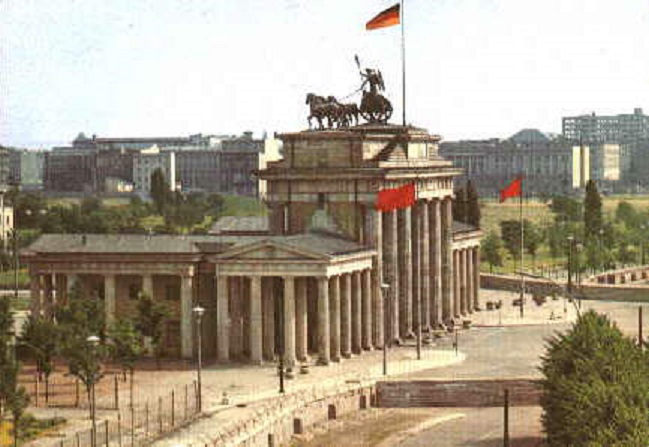
Big cities
The majority of the country's population was urban dwellers. In a small country, there were several cities with a population of more than half a million people. The large cities of the former German Democratic Republic, as a rule, had a rather ancient history. These are the cultural and economic centers of the country. The largest cities include Berlin, Dresden, Leipzig. The cities of East Germany were badly damaged. But Berlin suffered the most, where the fighting went literally for every house.
The largest cities were located in the south of the country: Karl-Marx-Stadt (Meissen), Dresden and Leipzig. Every city in the GDR was famous for something. Rostock, located in northern Germany, is a modern port city. The world-famous porcelain was produced in Karl-Marx-Stadt (Meissen). In Jena, there was the famous Carl Zeiss factory, which produced lenses, including for telescopes, famous binoculars and microscopes were produced here. This city was also famous for its universities and scientific institutions. This is a city of students. Schiller and Goethe once lived in Weimar.
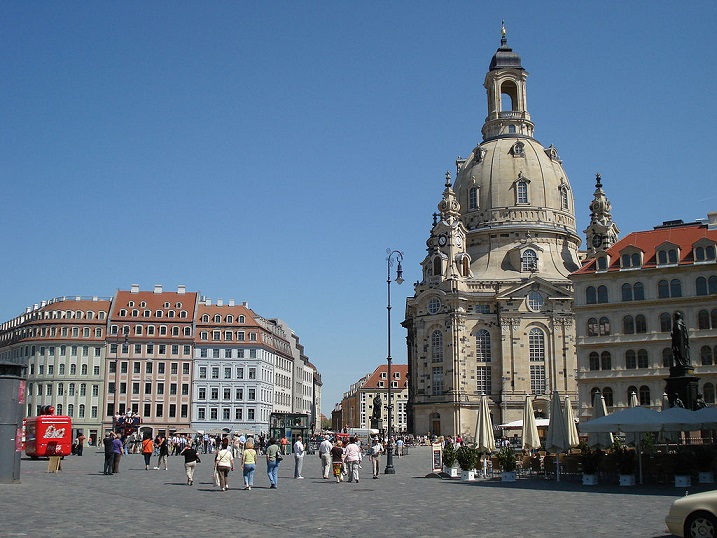
Karl-Marx-Stadt (1953-1990)
This city, founded in the 12th century in the land of Saxony, now bears its original name - Chemnitz. It is the center of textile engineering and textile industry, machine tool building and mechanical engineering. The city was completely destroyed by British and American bombers and rebuilt after the war. There are small islands of old buildings left.
Leipzig
The city of Leipzig, located in Saxony, was one of the largest cities in the German Democratic Republic before the unification of the GDR and the FRG. 32 kilometers away is another major German city - Halle, which is located in Saxony-Anhalt. Together, the two cities form an urban agglomeration with a population of 1,100,000 people.
The city has long been the cultural and scientific center of Central Germany. It is known for its universities as well as fairs. Leipzig is one of the most developed industrial regions in East Germany. Since the late Middle Ages, Leipzig has been a recognized center of printing and bookselling in Germany.
The greatest composer Johann Sebastian Bach lived and worked in this city, as well as the famous Felix Mendelssohn. The city is still famous for its musical traditions. Since ancient times, Leipzig has been a major trading center; until the last war, the famous fur trades were held here.
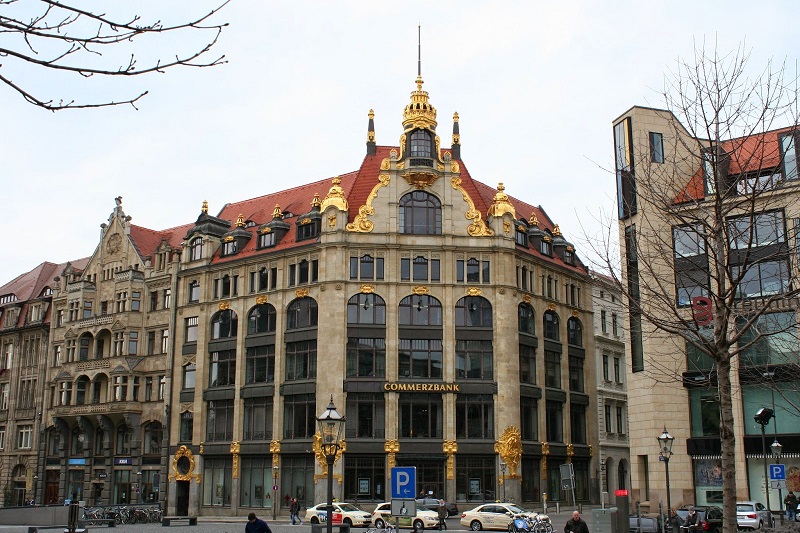
Dresden
The pearl among German cities is Dresden. The Germans themselves call it Florence on the Elbe, as there are many baroque architectural monuments here. The first mention of it was recorded in 1206. Dresden has always been the capital: since 1485 - the Margraviate of Meissen, since 1547 - the Electorate of Saxony.
It is located on the Elbe River. The border with the Czech Republic passes 40 kilometers from it. It is the administrative center of Saxony. Its population is about 600,000 inhabitants.
The city suffered greatly from the bombing of US and British aircraft. Up to 30,000 residents and refugees perished, most of them elderly, women and children. During the bombardment, the castle-residence, the Zwinger complex, and the Semperoper were badly destroyed. Almost the entire historical center lay in ruins.
In order to restore architectural monuments, after the war, all the surviving parts of the buildings were dismantled, rewritten, numbered and taken out of the city. Everything that could not be restored was cleared away.
The old city was a flat area on which most of the monuments were gradually restored. The government of the GDR came up with a proposal to revive the old city, which lasted almost forty years. For residents, new quarters and avenues were built around the old city.
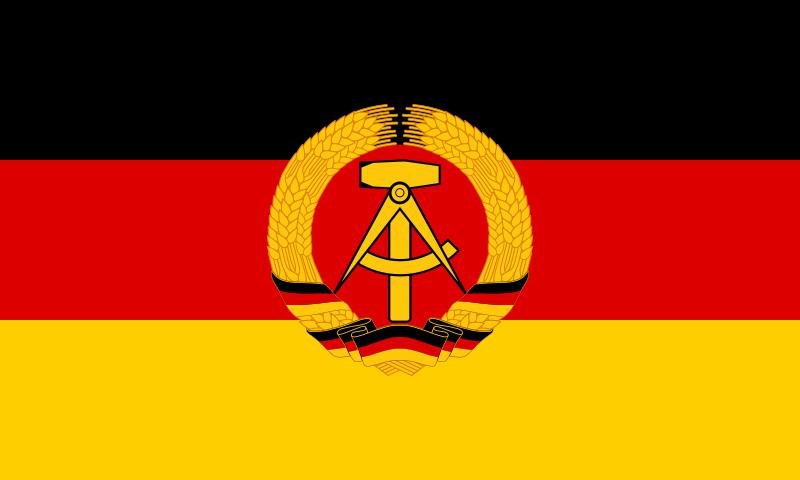
Coat of arms of the GDR
Like any country, the GDR had its own coat of arms, described in Chapter 1 of the constitution. The coat of arms of the German Democratic Republic consisted of a golden hammer superimposed on each other, embodying the working class, and a compass, personifying the intelligentsia. They were surrounded by a golden wreath of wheat, representing the peasantry, intertwined with ribbons of the national flag.
Flag of the GDR
The flag of the German Democratic Republic was an elongated panel consisting of four equal width stripes painted in the national colors of Germany: black, red and gold. In the middle of the flag was the coat of arms of the GDR, which distinguished it from the flag of the FRG.
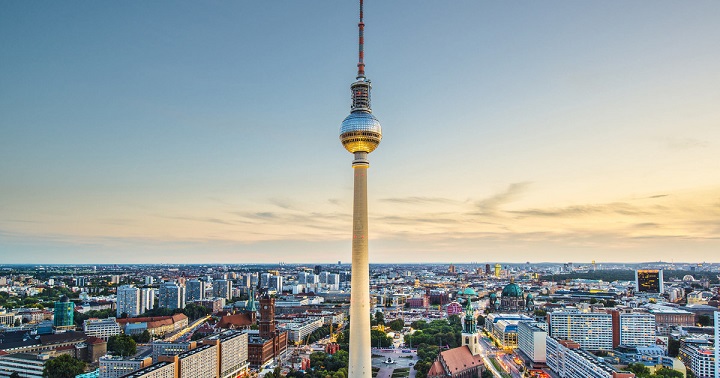
Prerequisites for the formation of the GDR
The history of the GDR covers a very short period of time, but it is still being studied with great attention by German scientists. The country was in strict isolation from the FRG and the entire Western world. After the surrender of Germany in May 1945, there were occupation zones, there were four of them, since the former state ceased to exist. All power in the country, with all management functions, formally passed to the military administrations.
The transitional period was complicated by the fact that Germany, especially its eastern part, where the German resistance was desperate, lay in ruins. The barbaric bombardments by British and American aircraft were intended to intimidate the civilian population of the cities that were liberated by the Soviet army, to turn them into a heap of ruins.
In addition, there was no agreement between the former allies regarding the vision of the future of the country, and this is what subsequently led to the creation of two countries - the Federal Republic of Germany and the German Democratic Republic.
Basic Principles for the Reconstruction of Germany
Even at the Yalta Conference, the basic principles for the restoration of Germany were considered, which were later fully agreed upon and approved at the conference in Potsdam by the victorious countries: the USSR, Great Britain and the USA. They were also approved by the countries that participated in the war against Germany, in particular France, and contained the following provisions:
- Complete destruction of the totalitarian state.
- Complete ban on the NSDAP and all organizations associated with it.
- The complete liquidation of the punitive organizations of the Reich, such as the SA, SS, SD services, as they were recognized as criminal.
- The army was completely liquidated.
- Racial and political laws were abolished.
- Gradual and consistent implementation of denazification, demilitarization and democratization.
The decision of the German question, which included a peace treaty, was entrusted to the Council of Ministers of the victorious countries. On June 5, 1945, the victorious states promulgated the Declaration of the Defeat of Germany, according to which the country was divided into four occupation zones controlled by the administrations of Great Britain (the largest zone), the USSR, the USA and France. The capital of Germany, Berlin, was also divided into zones. The decision of all issues was entrusted to the Control Council, it included representatives of the victorious countries.
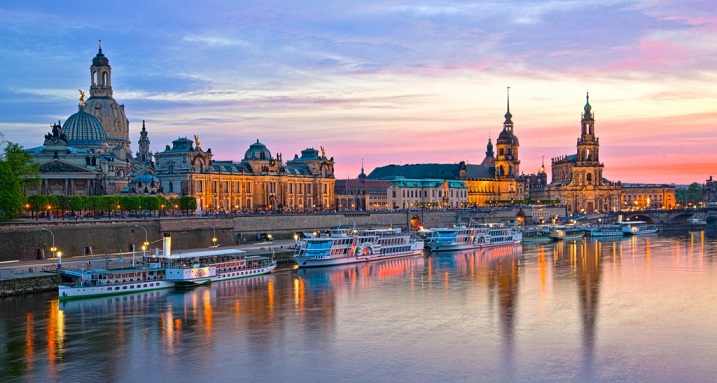
Party of Germany
In Germany, in order to restore statehood, the formation of new political parties that would be democratic in nature was allowed. In the eastern sector, emphasis was placed on the revival of the Communist and Social Democratic Party of Germany, which soon merged into the Socialist Unity Party of Germany (1946). Its goal was to build a socialist state. It was the ruling party in the German Democratic Republic.
In the western sectors, the CDU (Christian Democratic Union) party formed in June 1945 became the main political force. In 1946, the CSU (Christian-Social Union) was formed in Bavaria according to this principle. Their basic principle is a democratic republic based on market economy based on the rights of private property.
Political confrontations on the issue of the post-war structure of Germany between the USSR and the rest of the coalition countries were so serious that their further aggravation would lead either to a split of the state or to a new war.
Formation of the German Democratic Republic
In December 1946, Great Britain and the United States, ignoring numerous proposals from the USSR, announced the merger of their two zones. She was abbreviated as "Bizonia". This was preceded by the refusal of the Soviet administration to supply agricultural products to the western zones. In response to this, transit shipments of equipment exported from factories and plants in East Germany and located in the Ruhr region to the USSR zone were stopped.
At the beginning of April 1949, France also joined the Bizonia, as a result of which Trizonia was formed, from which the Federal Republic of Germany was subsequently formed. Thus, the Western powers, having entered into an agreement with the big German bourgeoisie, created a new state. In response to this, at the end of 1949, the German Democratic Republic was created. Berlin, or rather its Soviet zone, became its center and capital.
The People's Council was temporarily reorganized into the People's Chamber, which adopted the Constitution of the GDR, which passed a nationwide discussion. 09/11/1949 the first president of the GDR was elected. It was the legendary Wilhelm Pick. At the same time, the government of the GDR was temporarily created, headed by O. Grotewohl. The military administration of the USSR transferred all functions of governing the country to the government of the GDR.
The Soviet Union did not want the division of Germany. They were repeatedly made proposals for the unification and development of the country in accordance with the Potsdam decisions, but they were regularly rejected by Great Britain and the United States. Even after the division of Germany into two countries, Stalin made proposals for the unification of the GDR and the FRG, provided that the decisions of the Potsdam Conference were observed and that Germany was not drawn into any political and military blocs. But the Western states refused to do so, ignoring Potsdam's decisions.
The political system of the GDR
The form of government of the country was based on the principle of people's democracy, in which a bicameral parliament operated. The state system of the country was considered to be bourgeois-democratic, in which socialist transformations took place. The German Democratic Republic included the lands of the former Germany of Saxony, Saxony-Anhalt, Thuringia, Brandenburg, Mecklenburg-Vorpommern.
The lower (people's) chamber was elected by universal secret ballot. The upper chamber was called the Land Chamber, the executive body was the government, which consisted of the prime minister and ministers. It was formed by appointment, which was carried out by the largest faction of the People's Chamber.
The administrative-territorial division consisted of lands, consisting of districts, divided into communities. The functions of the legislature were carried out by the Landtags, the executive bodies were the governments of the lands.
The People's Chamber - the highest body of the state - consisted of 500 deputies, who were elected by the people by secret ballot for a term of 4 years. It was represented by all parties and public organizations. The People's Chamber, acting on the basis of laws, made the most important decisions on the development of the country, dealt with relations between organizations, observing the rules for cooperation between citizens, state organizations and associations; adopted the main law - the Constitution and other laws of the country.
Economy of the GDR
After the partition of Germany, the economic situation of the German Democratic Republic (GDR) was very difficult. This part of Germany was very badly destroyed. The equipment of plants and factories was taken to the western sectors of Germany. The GDR was simply cut off from the historical raw material bases, most of which were in the FRG. There was a lack of such natural resources as ore and coal. There were few specialists: engineers, executives who left for the FRG, frightened by the propaganda about the cruel reprisal of Russians.
With the help of the Union and other countries of the commonwealth, the economy of the GDR gradually began to gain momentum. Businesses were restored. It was believed that centralized leadership and a planned economy served as a deterrent to the development of the economy. It should be taken into account that the restoration of the country took place in isolation from the western part of Germany, in an atmosphere of tough confrontation between the two countries, open provocations.
Historically, the eastern regions of Germany were mostly agricultural, and in its western part, rich in coal and deposits of metal ores, heavy industry, metallurgy and engineering were concentrated.
Without the financial and material assistance of the Soviet Union, it would have been impossible to achieve an early restoration of industry. For the losses suffered by the USSR during the war years, the GDR paid him reparation payments. Since 1950, their volume has been halved, and in 1954 the USSR refused to receive them.
Foreign policy situation
The construction of the Berlin Wall by the German Democratic Republic became a symbol of the intransigence of the two blocs. The eastern and western blocs of Germany were building up their military forces, provocations from the western bloc became more frequent. It came to open sabotage and arson. The propaganda machine worked at full power, using economic and political difficulties. Germany, like many Western European countries, did not recognize the GDR. The peak of the aggravation of relations occurred in the early 1960s.
The so-called "German crisis" also arose thanks to West Berlin, which, legally being the territory of the Federal Republic of Germany, was located in the very center of the GDR. The border between the two zones was conditional. As a result of the confrontation between NATO blocs and the Warsaw bloc countries, the SED Politburo decides to build a border around West Berlin, which was a reinforced concrete wall 106 km long and 3.6 m high and a metal mesh fence 66 km long. She stood from August 1961 until November 1989.
After the merger of the GDR and the FRG, the wall was demolished, only a small section remained, which became the Berlin Wall memorial. In October 1990, the GDR became part of the FRG. The history of the German Democratic Republic, which existed for 41 years, is intensively studied and researched by scientists of modern Germany.
Despite the propaganda discrediting of this country, scientists are well aware that it gave Western Germany a lot. In a number of parameters, she surpassed her Western brother. Yes, the joy of reunification was genuine for the Germans, but it is not worth belittling the importance of the GDR, one of the most developed countries in Europe, and many in modern Germany understand this very well.



